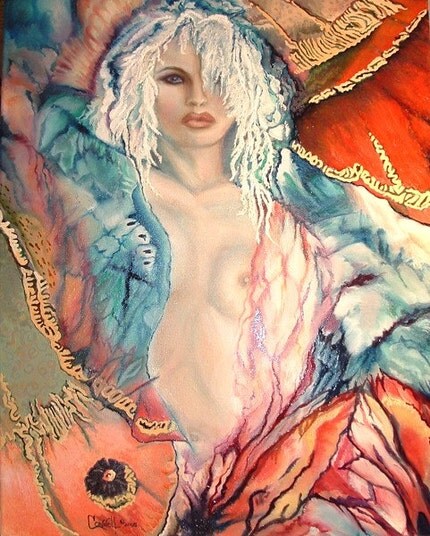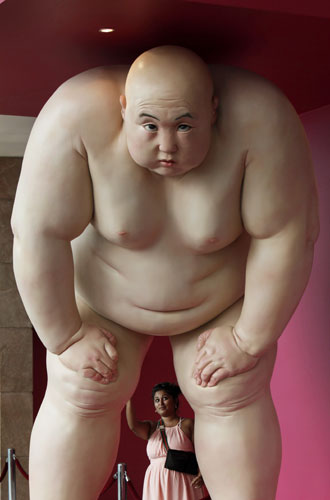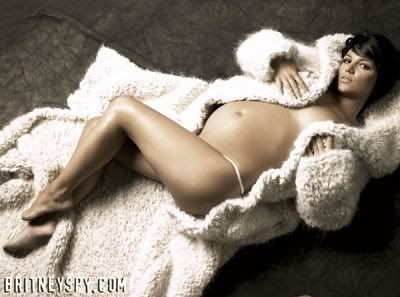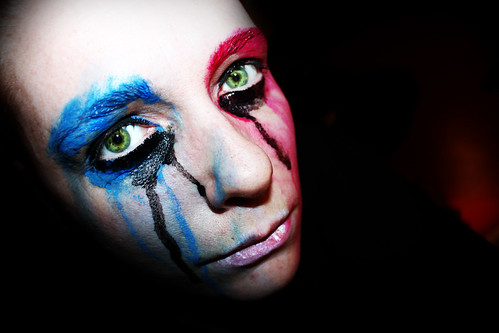
Nude, we all are! In our bathrooms, occasionally in our bedrooms, and when a celebrity is, everyone wants to shoot that precious moment by virtue of our hi-tech devices, we were not blessed with in ancient period when the only way to incarcerate those luxurious moments was either painting or sculpture

In the beginning, they were gods, goddesses and angles, shown naked in paintings as symbols of grace, beauty and innocence, but later on during and after renaissance, those were pretty women and handsome men painted undress under the strong wave of humanism, which ultimately supported freedom of expression. That work was simply called 'Nude' in art; the most popular as well as controversial it remained in all ages

Nudes were hard to accept openly in society but always had a strong appeal for viewers to give them a glance in public while, a detailed look in solitude. Texture and glow of skin, masterly crafted muscles, bones under the tender or strong flesh, skilled the canvas a depth and atmosphere so close to our imagination

Basically nudes are the concrete form of creator's thoughts and emotions under a certain instinct of wearing nothing but skin. There was no dress in the beginning of human history and might be so towards the end of 'human history'

But anatomical study has always been a challenge to be adept in, for painters and sculptors. Religiously nudes were subject to be free from any sensuality, on the contrary, they were taken as an expression of purity and had 'nothing to do with' attitude towards mortal life

Saints, goddesses and other sacred figures were above all social and ethical parameters but as soon as normal human beings were painted naked just to show them as humans, it was outlawed by righteous society. Manet's 'Lunch on the Grass' is one example of this dichotomy

When Raphael (1483-1520) painted 'THE THREE GRACES' and David (1460-1523) produced 'TRIPTYCH OF JEAN DES TROMPES, they promoted the religious thoughts and concepts, while Delacroix's famous 'LIBERTY LEADING THE PEOPLE' was a symbol of pride and honor one could feel for one's home land although the lady holding the flag was exposed at the top

Then comes Manet's (1832-1883) 'LUNCHEON THE GRASS' showing a naked women sitting with two gentlemen fully and formally dressed, looking directly into the eyes of the viewer. This painting was really hard to digest for the French society at that time, despite the fact that they were quite interactive with traditional 'Nudes', whereas 'OLYMPIA' by the same artist was bold enough to get appreciation for the impressionists

Goya's (1746-1828) 'NUDE MAJA' and Dega's (1834-1880) key-hole nudes of bathing women got applause and popularity in their respective times that helped this art to get the status of serious art rather than scramble to sensuous feelings alone! Especially Dega's crafty figures well-knit with softness of pastels became a byword of technique and thought

In the 20th century, Cubism, owing to its sharp and misty combination in shape and concept, struck art by means of pinching edges and overlapped images. Nude painting got more space to articulate itself, as the obscure and indistinct ambiance gave artists the opportunity to avoid meticulous anatomical details.

This style helped modern artists to enlarge the conceptual and subjective aspect of their paintings rather than objective reality related to humanism. Pablo Picasso was one of those artists, who not only gave nudes a new touch, but also caused the whole expression an indirect approach in terms of technique for certain meandering subjects

There was another stream of nude paintings that was neither sacred nor arty, but purely sensuous! That art was in demand for dance floors, casinos, brothel houses and strip clubs and other red- lit dark alleys. it could not get any place in serious art but these paintings did get different and innovative ideas applied on sensuously twitching figures. That painting also required perfection in skill as far as anatomical problems were concerned

In Pakistan, where even normal art has been a taboo since its beginning, what one could think about nude art? Must it exist here! It does actually! Pakistan has got some good and adroit painters who could fashion human anatomy with their skill and imagination and could furnish the canvass up to the level of 'a treat to watch'. Talism-e-Hoshruba by Ustad Alla Bakhsh has got tinges of semi exposed human bodies in a mystical atmosphere. Sadqain's paintings give you an idea about bodies of active, working human beings that do reflect painter's skill.
 Nude, we all are! In our bathrooms, occasionally in our bedrooms, and when a celebrity is, everyone wants to shoot that precious moment by virtue of our hi-tech devices, we were not blessed with in ancient period when the only way to incarcerate those luxurious moments was either painting or sculpture
Nude, we all are! In our bathrooms, occasionally in our bedrooms, and when a celebrity is, everyone wants to shoot that precious moment by virtue of our hi-tech devices, we were not blessed with in ancient period when the only way to incarcerate those luxurious moments was either painting or sculpture Nudes were hard to accept openly in society but always had a strong appeal for viewers to give them a glance in public while, a detailed look in solitude. Texture and glow of skin, masterly crafted muscles, bones under the tender or strong flesh, skilled the canvas a depth and atmosphere so close to our imagination
Nudes were hard to accept openly in society but always had a strong appeal for viewers to give them a glance in public while, a detailed look in solitude. Texture and glow of skin, masterly crafted muscles, bones under the tender or strong flesh, skilled the canvas a depth and atmosphere so close to our imagination Basically nudes are the concrete form of creator's thoughts and emotions under a certain instinct of wearing nothing but skin. There was no dress in the beginning of human history and might be so towards the end of 'human history'
Basically nudes are the concrete form of creator's thoughts and emotions under a certain instinct of wearing nothing but skin. There was no dress in the beginning of human history and might be so towards the end of 'human history' But anatomical study has always been a challenge to be adept in, for painters and sculptors. Religiously nudes were subject to be free from any sensuality, on the contrary, they were taken as an expression of purity and had 'nothing to do with' attitude towards mortal life
But anatomical study has always been a challenge to be adept in, for painters and sculptors. Religiously nudes were subject to be free from any sensuality, on the contrary, they were taken as an expression of purity and had 'nothing to do with' attitude towards mortal life Saints, goddesses and other sacred figures were above all social and ethical parameters but as soon as normal human beings were painted naked just to show them as humans, it was outlawed by righteous society. Manet's 'Lunch on the Grass' is one example of this dichotomy
Saints, goddesses and other sacred figures were above all social and ethical parameters but as soon as normal human beings were painted naked just to show them as humans, it was outlawed by righteous society. Manet's 'Lunch on the Grass' is one example of this dichotomy When Raphael (1483-1520) painted 'THE THREE GRACES' and David (1460-1523) produced 'TRIPTYCH OF JEAN DES TROMPES, they promoted the religious thoughts and concepts, while Delacroix's famous 'LIBERTY LEADING THE PEOPLE' was a symbol of pride and honor one could feel for one's home land although the lady holding the flag was exposed at the top
When Raphael (1483-1520) painted 'THE THREE GRACES' and David (1460-1523) produced 'TRIPTYCH OF JEAN DES TROMPES, they promoted the religious thoughts and concepts, while Delacroix's famous 'LIBERTY LEADING THE PEOPLE' was a symbol of pride and honor one could feel for one's home land although the lady holding the flag was exposed at the top Then comes Manet's (1832-1883) 'LUNCHEON THE GRASS' showing a naked women sitting with two gentlemen fully and formally dressed, looking directly into the eyes of the viewer. This painting was really hard to digest for the French society at that time, despite the fact that they were quite interactive with traditional 'Nudes', whereas 'OLYMPIA' by the same artist was bold enough to get appreciation for the impressionists
Then comes Manet's (1832-1883) 'LUNCHEON THE GRASS' showing a naked women sitting with two gentlemen fully and formally dressed, looking directly into the eyes of the viewer. This painting was really hard to digest for the French society at that time, despite the fact that they were quite interactive with traditional 'Nudes', whereas 'OLYMPIA' by the same artist was bold enough to get appreciation for the impressionists Goya's (1746-1828) 'NUDE MAJA' and Dega's (1834-1880) key-hole nudes of bathing women got applause and popularity in their respective times that helped this art to get the status of serious art rather than scramble to sensuous feelings alone! Especially Dega's crafty figures well-knit with softness of pastels became a byword of technique and thought
Goya's (1746-1828) 'NUDE MAJA' and Dega's (1834-1880) key-hole nudes of bathing women got applause and popularity in their respective times that helped this art to get the status of serious art rather than scramble to sensuous feelings alone! Especially Dega's crafty figures well-knit with softness of pastels became a byword of technique and thought In the 20th century, Cubism, owing to its sharp and misty combination in shape and concept, struck art by means of pinching edges and overlapped images. Nude painting got more space to articulate itself, as the obscure and indistinct ambiance gave artists the opportunity to avoid meticulous anatomical details.
In the 20th century, Cubism, owing to its sharp and misty combination in shape and concept, struck art by means of pinching edges and overlapped images. Nude painting got more space to articulate itself, as the obscure and indistinct ambiance gave artists the opportunity to avoid meticulous anatomical details. This style helped modern artists to enlarge the conceptual and subjective aspect of their paintings rather than objective reality related to humanism. Pablo Picasso was one of those artists, who not only gave nudes a new touch, but also caused the whole expression an indirect approach in terms of technique for certain meandering subjects
This style helped modern artists to enlarge the conceptual and subjective aspect of their paintings rather than objective reality related to humanism. Pablo Picasso was one of those artists, who not only gave nudes a new touch, but also caused the whole expression an indirect approach in terms of technique for certain meandering subjects There was another stream of nude paintings that was neither sacred nor arty, but purely sensuous! That art was in demand for dance floors, casinos, brothel houses and strip clubs and other red- lit dark alleys. it could not get any place in serious art but these paintings did get different and innovative ideas applied on sensuously twitching figures. That painting also required perfection in skill as far as anatomical problems were concerned
There was another stream of nude paintings that was neither sacred nor arty, but purely sensuous! That art was in demand for dance floors, casinos, brothel houses and strip clubs and other red- lit dark alleys. it could not get any place in serious art but these paintings did get different and innovative ideas applied on sensuously twitching figures. That painting also required perfection in skill as far as anatomical problems were concerned In Pakistan, where even normal art has been a taboo since its beginning, what one could think about nude art? Must it exist here! It does actually! Pakistan has got some good and adroit painters who could fashion human anatomy with their skill and imagination and could furnish the canvass up to the level of 'a treat to watch'. Talism-e-Hoshruba by Ustad Alla Bakhsh has got tinges of semi exposed human bodies in a mystical atmosphere. Sadqain's paintings give you an idea about bodies of active, working human beings that do reflect painter's skill.
In Pakistan, where even normal art has been a taboo since its beginning, what one could think about nude art? Must it exist here! It does actually! Pakistan has got some good and adroit painters who could fashion human anatomy with their skill and imagination and could furnish the canvass up to the level of 'a treat to watch'. Talism-e-Hoshruba by Ustad Alla Bakhsh has got tinges of semi exposed human bodies in a mystical atmosphere. Sadqain's paintings give you an idea about bodies of active, working human beings that do reflect painter's skill.

 Face painting is the artistic application of colours, drawings, and paints on face. Face painters and artist use paints to decorate their faces, to show their feelings, or desires through painting on their faces. This is done using the water based cosmetic paints, and it has become a very common activity for different parties, celebrations, and events
Face painting is the artistic application of colours, drawings, and paints on face. Face painters and artist use paints to decorate their faces, to show their feelings, or desires through painting on their faces. This is done using the water based cosmetic paints, and it has become a very common activity for different parties, celebrations, and events







